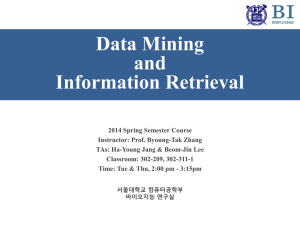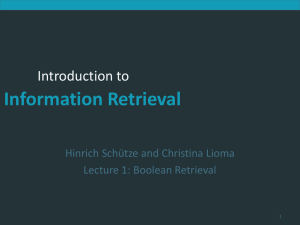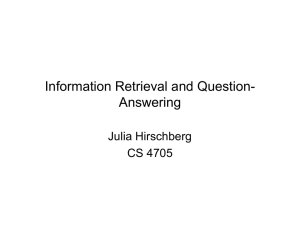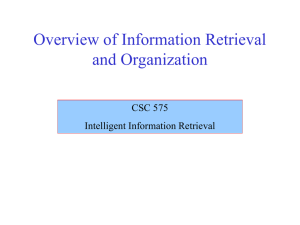Introduction to Information Retrieval
advertisement
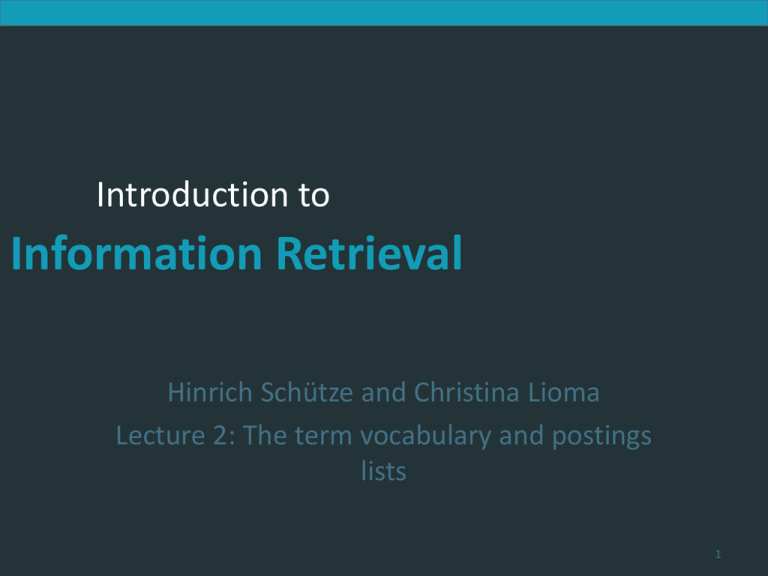
Introduction to Information Retrieval
Introduction to
Information Retrieval
Hinrich Schütze and Christina Lioma
Lecture 2: The term vocabulary and postings
lists
1
Introduction to Information Retrieval
Overview
❶
Recap
❷
Documents
❸
Terms
General + Non-English
English
❹
Skip pointers
❺
Phrase queries
2
Introduction to Information Retrieval
Outline
❶
Recap
❷
Documents
❸
Terms
General + Non-English
English
❹
Skip pointers
❺
Phrase queries
3
Introduction to Information Retrieval
Inverted Index
For each term t, we store a list of all documents that contain t.
dictionary
postings
4
Introduction to Information Retrieval
Intersecting two posting lists
5
Introduction to Information Retrieval
Constructing the inverted index: Sort postings
6
Introduction to Information Retrieval
Westlaw: Example queries
Information need: Information on the legal theories involved in
preventing the disclosure of trade secrets by employees formerly
employed by a competing company Query: “trade secret” /s
disclos! /s prevent /s employe! Information need: Requirements
for disabled people to be able to access a workplace Query:
disab! /p access! /s work-site work-place (employment /3 place)
Information need: Cases about a host’s responsibility for drunk
guests Query: host! /p (responsib! liab!) /p (intoxicat! drunk!)
/p guest
7
Introduction to Information Retrieval
Does Google use the Boolean model?
On Google, the default interpretation of a query [w1 w2 . . .wn]
is w1 AND w2 AND . . .AND wn
Cases where you get hits that do not contain one of the wi :
anchor text
page contains variant of wi (morphology, spelling correction,
synonym)
long queries (n large)
boolean expression generates very few hits
Simple Boolean vs. Ranking of result set
Simple Boolean retrieval returns matching documents in no
particular order.
Google (and most well designed Boolean engines) rank the result
set – they rank good hits (according to some estimator of
relevance) higher than bad hits.
8
Introduction to Information Retrieval
Take-away
Understanding of the basic unit of classical information
retrieval systems: words and documents: What is a document,
what is a term?
Tokenization: how to get from raw text to words (or tokens)
More complex indexes: skip pointers and phrases
9
Introduction to Information Retrieval
Outline
❶
Recap
❷
Documents
❸
Terms
General + Non-English
English
❹
Skip pointers
❺
Phrase queries
10
Introduction to Information Retrieval
Documents
Last lecture: Simple Boolean retrieval system
Our assumptions were:
We know what a document is.
We can “machine-read” each document.
This can be complex in reality.
11
Introduction to Information Retrieval
Parsing a document
We need to deal with format and language of each document.
What format is it in? pdf, word, excel, html etc.
What language is it in?
What character set is in use?
Each of these is a classification problem, which we will study
later in this course (IIR 13).
Alternative: use heuristics
12
Introduction to Information Retrieval
Format/Language: Complications
A single index usually contains terms of several languages.
Sometimes a document or its components contain multiple
languages/formats.
French email with Spanish pdf attachment
What is the document unit for indexing?
A file?
An email?
An email with 5 attachments?
A group of files (ppt or latex in HTML)?
Upshot: Answering the question “what is a document?” is not
trivial and requires some design decisions.
Also: XML
13
Introduction to Information Retrieval
Outline
❶
Recap
❷
Documents
❸
Terms
General + Non-English
English
❹
Skip pointers
❺
Phrase queries
14
Introduction to Information Retrieval
Outline
❶
Recap
❷
Documents
❸
Terms
General + Non-English
English
❹
Skip pointers
❺
Phrase queries
15
Introduction to Information Retrieval
Definitions
Word – A delimited string of characters as it appears in the
text.
Term – A “normalized” word (case, morphology, spelling etc);
an equivalence class of words.
Token – An instance of a word or term occurring in a
document.
Type – The same as a term in most cases: an equivalence class
of tokens.
16
Introduction to Information Retrieval
Normalization
Need to “normalize” terms in indexed text as well as query
terms into the same form.
Example: We want to match U.S.A. and USA
We most commonly implicitly define equivalence classes of
terms.
Alternatively: do asymmetric expansion
window → window, windows
windows → Windows, windows
Windows (no expansion)
More powerful, but less efficient
Why don’t you want to put window, Window, windows, and
Windows in the same equivalence class?
17
Introduction to Information Retrieval
Normalization: Other languages
Normalization and language detection interact.
PETER WILL NICHT MIT. → MIT = mit
He got his PhD from MIT. → MIT ≠ mit
18
Introduction to Information Retrieval
Recall: Inverted index construction
Input:
Output:
Each token is a candidate for a postings entry.
What are valid tokens to emit?
19
Introduction to Information Retrieval
Exercises
In June, the dog likes to chase the cat in the barn. – How many
word tokens? How many word types? Why tokenization is difficult
– even in English. Tokenize: Mr. O’Neill thinks that the boys’
stories about Chile’s capital aren’t amusing.
20
Introduction to Information Retrieval
Tokenization problems: One word or two? (or
several)
Hewlett-Packard
State-of-the-art
co-education
the hold-him-back-and-drag-him-away maneuver
data base
San Francisco
Los Angeles-based company
cheap San Francisco-Los Angeles fares
York University vs. New York University
21
Introduction to Information Retrieval
Numbers
3/20/91
20/3/91
Mar 20, 1991
B-52
100.2.86.144
(800) 234-2333
800.234.2333
Older IR systems may not index numbers . . .
. . . but generally it’s a useful feature.
22
Introduction to Information Retrieval
Chinese: No whitespace
23
Introduction to Information Retrieval
Ambiguous segmentation in Chinese
The two characters can be treated as one word meaning
‘monk’ or as a sequence of two words meaning ‘and’ and ‘still’.
24
Introduction to Information Retrieval
Other cases of “no whitespace”
Compounds in Dutch, German, Swedish
Computerlinguistik → Computer + Linguistik
Lebensversicherungsgesellschaftsangestellter
→ leben + versicherung + gesellschaft + angestellter
Inuit: tusaatsiarunnanngittualuujunga (I can’t hear very well.)
Many other languages with segmentation difficulties: Finnish,
Urdu, . . .
25
Introduction to Information Retrieval
Japanese
4 different “alphabets”: Chinese characters, hiragana syllabary
for inflectional endings and functional words, katakana
syllabary for transcription of foreign words and other uses,
and latin. No spaces (as in Chinese). End user can express
query entirely in hiragana!
26
Introduction to Information Retrieval
Arabic script
27
Introduction to Information Retrieval
Arabic script: Bidirectionality
← →
← →
← START
‘Algeria achieved its independence in 1962 after 132 years of French occupation.’
Bidirectionality is not a problem if text is coded in Unicode.
28
Introduction to Information Retrieval
Accents and diacritics
Accents: résumé vs. resume (simple omission of accent)
Umlauts: Universität vs. Universitaet (substitution with special
letter sequence “ae”)
Most important criterion: How are users likely to write their
queries for these words?
Even in languages that standardly have accents, users often do
not type them. (Polish?)
29
Introduction to Information Retrieval
Outline
❶
Recap
❷
Documents
❸
Terms
General + Non-English
English
❹
Skip pointers
❺
Phrase queries
30
Introduction to Information Retrieval
Case folding
Reduce all letters to lower case
Possible exceptions: capitalized words in mid-sentence
MIT vs. mit
Fed vs. fed
It’s often best to lowercase everything since users will use
lowercase regardless of correct capitalization.
31
Introduction to Information Retrieval
Stop words
stop words = extremely common words which would appear
to be of little value in helping select documents matching a
user need
Examples: a, an, and, are, as, at, be, by, for, from, has, he, in,
is, it, its, of, on, that, the, to, was, were, will, with
Stop word elimination used to be standard in older IR
systems.
But you need stop words for phrase queries, e.g. “King of
Denmark”
Most web search engines index stop words.
32
Introduction to Information Retrieval
More equivalence classing
Soundex: IIR 3 (phonetic equivalence, Muller = Mueller)
Thesauri: IIR 9 (semantic equivalence, car = automobile)
33
Introduction to Information Retrieval
Lemmatization
Reduce inflectional/variant forms to base form
Example: am, are, is → be
Example: car, cars, car’s, cars’ → car
Example: the boy’s cars are different colors → the boy car be
different color
Lemmatization implies doing “proper” reduction to
dictionary headword form (the lemma).
Inflectional morphology (cutting → cut) vs. derivational
morphology (destruction → destroy)
34
Introduction to Information Retrieval
Stemming
Definition of stemming: Crude heuristic process that chops
off the ends of words in the hope of achieving what
“principled” lemmatization attempts to do with a lot of
linguistic knowledge.
Language dependent
Often inflectional and derivational
Example for derivational: automate, automatic, automation
all reduce to automat
35
Introduction to Information Retrieval
Porter algorithm
Most common algorithm for stemming English
Results suggest that it is at least as good as other stemming
options
Conventions + 5 phases of reductions
Phases are applied sequentially
Each phase consists of a set of commands.
Sample command: Delete final ement if what remains is longer
than 1 character
replacement → replac
cement → cement
Sample convention: Of the rules in a compound command,
select the one that applies to the longest suffix.
36
Introduction to Information Retrieval
Porter stemmer: A few rules
Rule
SSES → SS
IES → I
SS → SS
S→
Example
caresses → caress
ponies → poni
caress → caress
cats → cat
37
Introduction to Information Retrieval
Three stemmers: A comparison
Sample text:
Such an analysis can reveal features that are not easil
visible from the variations in the individual genes and
can lead to a picture of expression that is more
biologically transparent and accessible to interpretation
Porter stemmer: such an analysi can reveal featur that ar not easili visibl
from the variat in the individu gene and can lead to
pictur of express that is more biolog transpar and
access to interpret
Lovins stemmer: such an analys can reve featur that ar not eas vis from
th vari in th individu gen and can lead to a pictur of
expres that is mor biolog transpar and acces to
interpres
Paice stemmer: such an analys can rev feat that are not easy vis from
the vary in the individ gen and can lead to a pict of
express that is mor biolog transp and access to interpret
38
Introduction to Information Retrieval
Does stemming improve effectiveness?
In general, stemming increases effectiveness for some
queries, and decreases effectiveness for others.
Queries where stemming is likely to help: [tartan sweaters],
[sightseeing tour san francisco] (equivalence classes:
{sweater,sweaters}, {tour,tours})
Porter Stemmer equivalence class oper contains all of
operate operating operates operation operative operatives
operational.
Queries where stemming hurts: [operational AND research],
[operating AND system], [operative AND dentistry]
39
Introduction to Information Retrieval
Exercise: What does Google do?
Stop words
Normalization
Tokenization
Lowercasing
Stemming
Non-latin alphabets
Umlauts
Compounds
Numbers
40
Introduction to Information Retrieval
Outline
❶
Recap
❷
Documents
❸
Terms
General + Non-English
English
❹
Skip pointers
❺
Phrase queries
41
Introduction to Information Retrieval
Recall basic intersection algorithm
Linear in the length of the postings lists.
Can we do better?
42
Introduction to Information Retrieval
Skip pointers
Skip pointers allow us to skip postings that will not figure in
the search results.
This makes intersecting postings lists more efficient.
Some postings lists contain several million entries – so
efficiency can be an issue even if basic intersection is linear.
Where do we put skip pointers?
How do we make sure intersection results are correct?
43
Introduction to Information Retrieval
Basic idea
44
Introduction to Information Retrieval
Skip lists: Larger example
45
Introduction to Information Retrieval
Intersection with skip pointers
46
Introduction to Information Retrieval
Where do we place skips?
Tradeoff: number of items skipped vs. frequency skip can be
taken
More skips: Each skip pointer skips only a few items, but we
can frequently use it.
Fewer skips: Each skip pointer skips many items, but we can
not use it very often.
47
Introduction to Information Retrieval
Where do we place skips? (cont)
Simple heuristic: for postings list of length P, use
evenly-spaced skip pointers.
This ignores the distribution of query terms.
Easy if the index is static; harder in a dynamic environment
because of updates.
How much do skip pointers help?
They used to help a lot.
With today’s fast CPUs, they don’t help that much anymore.
48
Introduction to Information Retrieval
Outline
❶
Recap
❷
Documents
❸
Terms
General + Non-English
English
❹
Skip pointers
❺
Phrase queries
49
Introduction to Information Retrieval
Phrase queries
We want to answer a query such as [stanford university] – as
a phrase.
Thus The inventor Stanford Ovshinsky never went to
university should not be a match.
The concept of phrase query has proven easily understood by
users.
About 10% of web queries are phrase queries.
Consequence for inverted index: it no longer suffices to store
docIDs in postings lists.
Two ways of extending the inverted index:
biword index
positional index
50
Introduction to Information Retrieval
Biword indexes
Index every consecutive pair of terms in the text as a phrase.
For example, Friends, Romans, Countrymen would generate
two biwords: “friends romans” and “romans countrymen”
Each of these biwords is now a vocabulary term.
Two-word phrases can now easily be answered.
51
Introduction to Information Retrieval
Longer phrase queries
A long phrase like “stanford university palo alto” can be
represented as the Boolean query “STANFORD UNIVERSITY” AND
“UNIVERSITY PALO” AND “PALO ALTO”
We need to do post-filtering of hits to identify subset that
actually contains the 4-word phrase.
52
Introduction to Information Retrieval
Extended biwords
Parse each document and perform part-of-speech tagging
Bucket the terms into (say) nouns (N) and
articles/prepositions (X)
Now deem any string of terms of the form NX*N to be an
extended biword
Examples: catcher in the rye
N
X X N
king of Denmark
N X N
Include extended biwords in the term vocabulary
Queries are processed accordingly
53
Introduction to Information Retrieval
Issues with biword indexes
Why are biword indexes rarely used?
False positives, as noted above
Index blowup due to very large term vocabulary
54
Introduction to Information Retrieval
Positional indexes
Positional indexes are a more efficient alternative to biword
indexes.
Postings lists in a nonpositional index: each posting is just a
docID
Postings lists in a positional index: each posting is a docID and
a list of positions
55
Introduction to Information Retrieval
Positional indexes: Example
Query: “to1 be2 or3 not4 to5 be6” TO, 993427:
‹ 1: ‹7, 18, 33, 72, 86, 231›;
2: ‹1, 17, 74, 222, 255›;
4: ‹8, 16, 190, 429, 433›;
5: ‹363, 367›;
7: ‹13, 23, 191›; . . . ›
BE, 178239:
‹ 1: ‹17, 25›;
4: ‹17, 191, 291, 430, 434›;
5: ‹14, 19, 101›; . . . › Document 4 is a match!
56
Introduction to Information Retrieval
Proximity search
We just saw how to use a positional index for phrase
searches.
We can also use it for proximity search.
For example: employment /4 place
Find all documents that contain EMPLOYMENT and PLACE within
4 words of each other.
Employment agencies that place healthcare workers are
seeing growth is a hit.
Employment agencies that have learned to adapt now place
healthcare workers is not a hit.
57
Introduction to Information Retrieval
Proximity search
Use the positional index
Simplest algorithm: look at cross-product of positions of (i)
EMPLOYMENT in document and (ii) PLACE in document
Very inefficient for frequent words, especially stop words
Note that we want to return the actual matching positions,
not just a list of documents.
This is important for dynamic summaries etc.
58
Introduction to Information Retrieval
“Proximity” intersection
59
Introduction to Information Retrieval
Combination scheme
Biword indexes and positional indexes can be profitably
combined.
Many biwords are extremely frequent: Michael Jackson,
Britney Spears etc
For these biwords, increased speed compared to positional
postings intersection is substantial.
Combination scheme: Include frequent biwords as vocabulary
terms in the index. Do all other phrases by positional
intersection.
Williams et al. (2004) evaluate a more sophisticated mixed
indexing scheme. Faster than a positional index, at a cost of
26% more space for index.
60
Introduction to Information Retrieval
“Positional” queries on Google
For web search engines, positional queries are much more
expensive than regular Boolean queries.
Let’s look at the example of phrase queries.
Why are they more expensive than regular Boolean queries?
Can you demonstrate on Google that phrase queries are
more expensive than Boolean queries?
61
Introduction to Information Retrieval
Take-away
Understanding of the basic unit of classical information
retrieval systems: words and documents: What is a
document, what is a term?
Tokenization: how to get from raw text to words (or tokens)
More complex indexes: skip pointers and phrases
62
Introduction to Information Retrieval
Resources
Chapter 2 of IIR
Resources at http://ifnlp.org/ir
Porter stemmer
63

